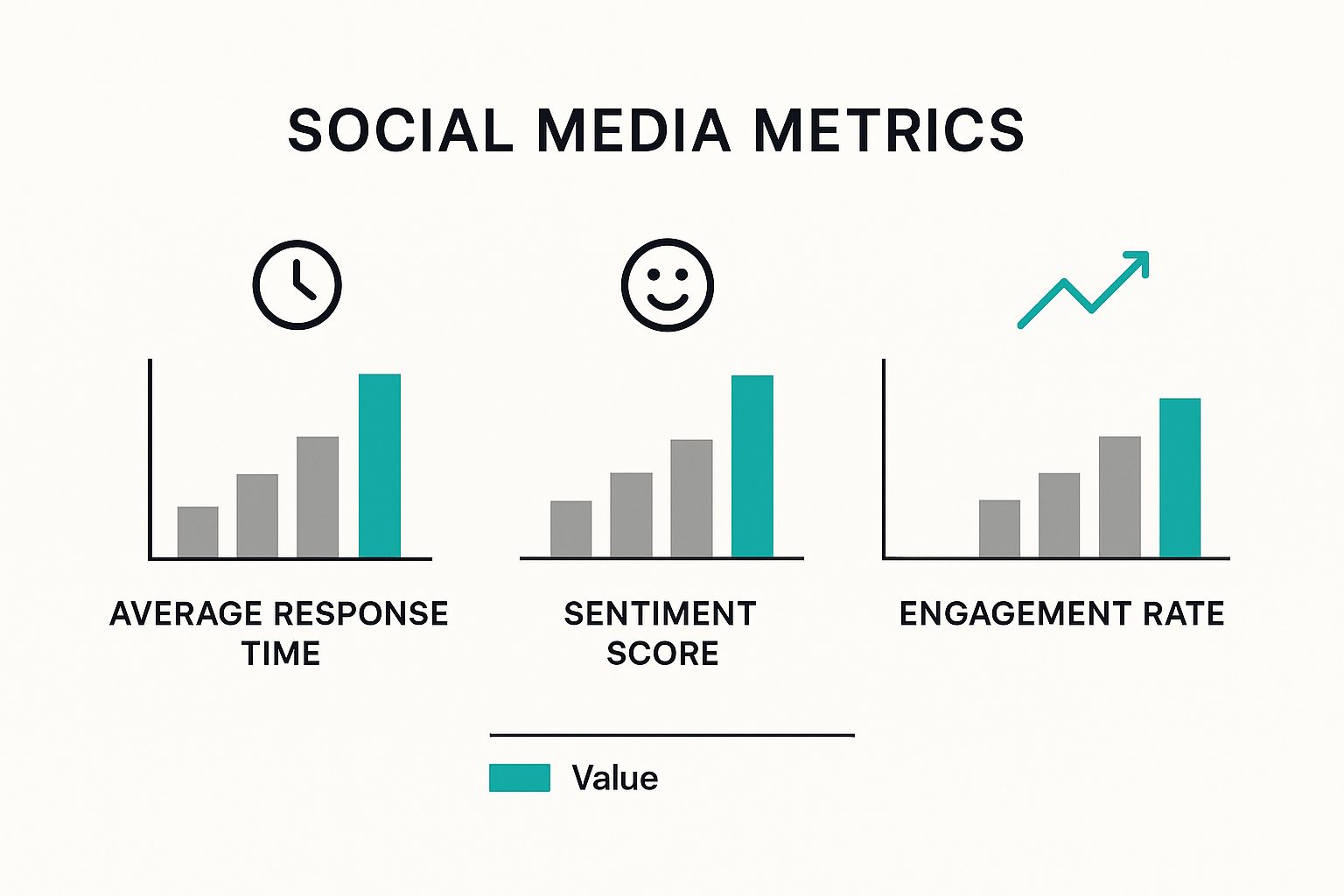Mastering Social Media Reputation Management
Social media reputation management is all about keeping an eye on, shaping, and managing what people think of your brand across social networks. It’s a hands-on process of listening to conversations, jumping in to engage with your audience, and guiding the online narrative to build and protect a positive image. This matters because what people say about you online has a direct line to trust, loyalty, and their decision to buy from you.
Understanding Your Digital Echo
Picture your brand's social media presence as a huge, non-stop digital party. Every single comment, share, tag, and review is part of a conversation happening about you, whether you’re there to hear it or not.
All that chatter creates what I call a "digital echo"—the perception of your brand that bounces around from platform to platform. Social media reputation management is simply the art of tuning into that echo, figuring out its tone, and then actively joining the conversation to make sure it reflects who you really are.
Leaving this echo to chance is like letting strangers define you. In a world where a story can circle the globe in minutes, one bad comment can snowball into a disaster, while a glowing one can become your most powerful testimonial. It's not just about broadcasting marketing messages anymore; it's about a real, two-way dialogue that builds a community and cements your credibility.
Why It Is a Core Business Function
Managing your online reputation isn't just a side gig for the marketing team. It’s a core business function with a straight-line connection to your bottom line.
Think about it: the modern customer journey is almost guaranteed to have a digital stop. And for many, social media is the first place they go for raw, unfiltered feedback about a company. This shift in how people shop makes proactive management an absolute must.
The numbers don't lie. Consumers lean heavily on social proof before they pull out their wallets. By 2025, more than 75% of people will check online reviews before buying something, and a staggering 91% of consumers aged 18-34 trust businesses with positive feedback. On top of that, 70% of people now expect brands to offer customer service on social media, making these platforms the new frontline for support. You can dive deeper into these trends in HiFiveStar's 2025 report.
Your brand isn’t what you say it is. It’s what Google says it is—and more importantly, what your customers say it is on social media.
This simple truth is what turns reputation management from a defensive chore into a powerful engine for growth.
The Pillars of a Strong Online Reputation
A solid strategy doesn't just happen. It's built on a few key pillars that work together to create a brand image that's both positive and resilient. Each one tackles a different piece of how your audience sees and interacts with you online.
This table breaks down the essential components, making it easy to see where to focus your efforts.
The Pillars of a Strong Online Reputation
| Pillar | Objective | Key Activities |
|---|---|---|
| Proactive Monitoring | To stay informed about all brand-related conversations online. | Tracking mentions of your brand, products, and key people across social channels. Listening for both direct tags and indirect conversations. |
| Strategic Engagement | To build a loyal community and manage perceptions in real-time. | Responding to all comments (good and bad), answering questions, and thanking customers. Turning passive followers into active advocates. |
| Content That Builds Trust | To establish authority and reinforce your desired brand image. | Creating and sharing valuable, authentic, and helpful content that gives your audience a reason to trust and follow you. |
| Crisis Preparedness | To mitigate damage from negative events quickly and effectively. | Developing a clear response plan for negative feedback or potential crises. Being ready to act swiftly and transparently. |
Let's unpack what each of these really looks like in practice.
Proactive Monitoring: This is your early warning system. It means constantly keeping tabs on mentions of your brand, products, executives, and even your competitors across every social platform. You’re listening not just for the times you’re tagged directly, but for those quieter, indirect conversations that tell you what people really think.
Strategic Engagement: This is where you get in the game. It’s all about actively participating in the conversation. That means replying to comments (yes, the good and the bad), answering questions promptly, and showing appreciation for customer feedback. This is how you turn a faceless follower count into a thriving, engaged community.
Content That Builds Trust: Your content strategy needs to be more than just a sales pitch; it has to back up the reputation you want. By consistently sharing content that is valuable, authentic, and genuinely helpful, you position yourself as an authority and give your audience solid reasons to trust you—and even recommend you.
Crisis Preparedness: You can't prevent every fire, but you can have an extinguisher ready. This pillar is about having a clear, pre-approved plan for handling negative feedback or a full-blown crisis. A fast, well-handled response can minimize the damage and sometimes even turn a negative into a positive by showing you’re transparent and committed to your customers.
How to Build a Proactive Reputation Strategy

The best social media reputation management isn't about scrambling to put out fires after they’ve started. It’s about building a brand so resilient that the occasional spark doesn’t even faze it. This is the difference between being reactive and being proactive—shaping the narrative before someone else does.
Think of it like building a house with a solid foundation. You don’t wait for a storm to see if the walls will hold. You carefully lay each brick of goodwill, trust, and positive interaction to create a structure that's built to last. It all starts with defining who you are and then showing up as that brand, every single day.
Define Your Brand Voice and Messaging
Your brand voice is your company's personality. Are you the witty, informal friend or the seasoned, authoritative expert? A consistent voice makes you instantly recognizable and helps forge a real connection with your audience.
Once you’ve locked it in, that voice needs to be everywhere—from your main posts and stories to the way you handle comments and DMs. Consistency breeds familiarity, and familiarity builds the trust that is the bedrock of a great reputation.
To get your whole team on the same page, create a simple style guide that covers:
- Tone: The overall vibe of your communication (e.g., helpful, playful, inspiring).
- Vocabulary: Words and phrases you lean into and others you avoid.
- Formatting: Your rules for using emojis, hashtags, and other platform quirks.
Create a Content Plan That Reflects Your Values
Your content is your #1 reputation-building tool. It's your chance to show what you know, stand for your values, and tell your story your way. A great content strategy is never just about selling; it’s about delivering real value.
A plan designed to build your reputation should be a mix of content that builds trust and authority. This could mean sharing customer success stories, giving a behind-the-scenes peek at your company culture, or creating educational posts that actually solve your audience's problems.
A proactive content strategy turns your social media feed into a living portfolio of your brand's integrity. It provides constant, tangible proof of your values, building a buffer of goodwill that pays dividends during challenging times.
This kind of content acts as social proof, reinforcing the positive image you want to project. It also gives people a reason to engage with you and, even better, to advocate on your behalf.
Encourage Positive Reviews and User-Generated Content
Nothing sells you better than a happy customer. Actively encouraging positive reviews and user-generated content (UGC) is one of the most powerful moves you can make in social media reputation management.
A LinkedIn study found that 75% of B2B buyers use social media to research purchases, which makes social proof incredibly powerful. You can get more of it by:
- Just Asking: A simple, polite follow-up email after a good experience with a direct link to a review site works wonders.
- Making It Easy: Put QR codes in your store or add direct links to your Google or Facebook review pages right in your social bios.
- Celebrating Your Customers: When someone posts great UGC, share it (with their permission, of course!). This not only gives you authentic content but also inspires others to do the same.
This strategy fills your feed with genuine praise and sends positive signals to search engines. Encouraging this kind of feedback is a core part of any good growth strategy, much like how businesses approach lead generation. In fact, if you're looking to grow, our beginner’s guide to B2B lead generation touches on similar principles of proactive outreach.
Mastering the Art of Social Listening
 Just keeping tabs on brand mentions is like hearing background noise at a party. You might catch your name, but you're missing the conversation. Social listening is the difference—it’s about leaning in to understand what’s actually being said and why it matters.
Just keeping tabs on brand mentions is like hearing background noise at a party. You might catch your name, but you're missing the conversation. Social listening is the difference—it’s about leaning in to understand what’s actually being said and why it matters.
This simple shift turns your social media efforts from a passive, defensive game into an active, intelligence-gathering mission.
Think of it this way: a security guard just reacts when someone shouts your name. A detective, on the other hand, pieces together whispers, body language, and context to get the real mood of the room. The guard reacts to loud noises; the detective anticipates what’s coming next. That’s the power of real social listening.
And you need to be a detective, because the volume of conversation is staggering. Consumers mention brands about 90 times per week, and 78% of them say social media posts directly influence what they buy. With 75% of people using social platforms to research products, your online reputation isn't just a vanity metric—it's a direct line to your bottom line.
What to Track Besides Your Brand Name
Effective social listening goes way beyond setting up a simple alert for your company handle. To get the full picture, your detective work needs to cover a wider range of clues.
A solid strategy involves tracking several key areas to build a complete intelligence report on where your brand really stands:
- Product and Service Keywords: You need to listen for conversations about the solutions you provide, even when your brand isn't named. This is how you find potential customers who are looking for exactly what you sell.
- Competitor Mentions: Keep a close eye on what people say about your competitors. Their customers’ complaints are your business opportunities, and their wins can teach you a thing or two.
- Key Industry Topics and Hashtags: Follow the broader industry chatter to understand shifting trends and sentiment. This helps you jump into relevant conversations and position your brand as a voice of authority.
- Executive Names: Your company leaders’ reputations are tied directly to your brand's. Monitoring their names helps you manage their personal brand and catch any related discussions, good or bad.
When you broaden your listening parameters like this, you start gathering the context needed to make smart decisions instead of just reacting to random comments. You'll finally see the "why" behind the "what."
Turning Raw Data into Actionable Insights
Collecting mentions is just the first step. The real magic happens when you turn that firehose of data into insights that actually inform your business strategy. This is where you connect the dots.
For example, let's say you notice a spike in negative comments around a competitor's latest product update. That's an insight. The action could be launching a targeted campaign that highlights your product’s reliability and superior features.
Social listening is the bridge between public conversation and business intelligence. It translates unstructured social chatter into a clear roadmap for improving products, refining marketing messages, and preempting potential crises.
This process leans heavily on sentiment analysis, which automatically sorts mentions into positive, negative, or neutral buckets. Modern tools use AI to analyze the tone and intent behind the words, giving you a much clearer picture of public perception. It’s a critical part of any serious social media reputation monitoring plan.
Choosing the Right Social Listening Tools
Your toolkit can range from simple, free options to incredibly powerful enterprise platforms. The right choice really depends on your budget, team size, and how deep you need to go.
Here’s a quick breakdown of what’s out there:
- Free and Basic Tools: Things like Google Alerts and the native search functions on sites like X (formerly Twitter) are perfect starting points. They’re great for tracking direct brand mentions and keywords without any cost.
- Dedicated Social Listening Platforms: Tools like Brandwatch or Talkwalker are built for deep analytics. They offer advanced sentiment analysis and trend identification for teams that need to dig into consumer insights and competitive intelligence.
- All-in-One Management Suites: Many social media management platforms like Hootsuite or Sprout Social include solid listening features alongside their scheduling and reporting tools. These are ideal for teams that want everything integrated into one daily workflow.
By picking the right tools and focusing on analysis over simple data collection, you can truly master the art of social listening. It stops being a chore and becomes one of your most valuable sources of business intelligence.
Responding to Negative Feedback and Crises

No matter how buttoned-up your social media strategy is, negative comments are going to happen. It’s not a matter of if, but when. The way you handle these moments says everything about your brand's character—it can either chip away at customer trust or, surprisingly, make it even stronger.
Think of a negative comment as a stress test for your brand’s integrity. A flimsy, defensive response will crack under the first sign of pressure. But a thoughtful, structured one shows you’re resilient and reinforces your customers' confidence in you. The trick is to have a playbook ready before the storm hits, so your team can act decisively instead of reacting defensively.
This isn’t just a nice-to-have skill anymore; it’s a core business function. The global online reputation management market is expected to jump from an estimated $5.2 billion in 2024 to $14.02 billion by 2031. That explosion tells you everything you need to know about how critical it is to manage your digital presence under the constant eye of public scrutiny.
The Four Stages of an Effective Response
When that negative comment pops up, your process needs to be immediate, empathetic, and organized. Following a clear, four-stage framework helps you address the issue without making those common, heat-of-the-moment mistakes that only make things worse.
Acknowledge Quickly: Speed is your best friend here. A prompt reply shows you're listening and that you take the concern seriously. Even a simple, "Thanks for letting us know about this. We're looking into it right now," can immediately de-escalate the tension by making the customer feel heard.
Empathize Genuinely: Before you jump to solutions, connect on a human level. Phrases like, "I can definitely understand your frustration," or "That sounds like a really difficult experience," validate the customer’s feelings. It shifts the tone from a confrontation to a collaboration.
Investigate Thoroughly: After that initial public acknowledgment, it's time to get the facts straight behind the scenes. Talk to the right team members and pull up the customer's history. A well-informed response is always better than a rushed one that gets the details wrong.
Resolve Transparently: Always close the loop. If it makes sense, share the resolution publicly to show other customers that you follow through on your word. This could be anything from a sincere apology to a detailed explanation of the fix.
Golden Rules of Crisis Communication
Beyond the step-by-step process, a few core principles should guide your actions when the stakes are high. These rules help you keep control of the narrative and protect your brand for the long haul.
Know When to Go Offline: Your first response can be public, but the nitty-gritty of solving the problem should move to a private channel like DMs or email. A public back-and-forth almost always escalates the drama. A simple, "We've sent you a DM to get a few more details and sort this out for you," is the perfect way to make that transition.
Never Delete Legitimate Criticism: Wiping negative comments (unless it’s spam or hate speech) is like pouring gasoline on a fire. It screams that you have something to hide and can turn one unhappy customer into a mob.
Stay United as a Team: Make sure everyone on your team is on the same page with the messaging. Conflicting responses from different people create confusion and completely undermine your credibility.
A crisis doesn’t create a company’s character; it reveals it. A calm, empathetic, and unified response demonstrates that your brand’s values hold up under pressure, building deeper trust than you had before the incident.
Creating a Simple Crisis Communication Plan
You don’t need a 100-page binder gathering dust on a shelf. A simple, one-page plan can give your team the clarity they need to act effectively when things go sideways. Make sure this plan is easy for everyone managing your social channels to find. For a deeper dive, you can also explore smart crisis communications across online channels to sharpen your approach.
Your basic plan should cover these four bases:
- Key Roles and Responsibilities: Who’s the main point of contact? Who has the authority to approve official statements?
- Response Triage System: A simple flowchart to help your team classify an issue's severity (e.g., minor complaint vs. potential crisis) and know which protocol to follow.
- Pre-Approved Holding Statements: A few ready-to-go responses for common scenarios. These can be posted immediately while you investigate, buying you precious time.
- Internal Communication Protocol: A clear process for how the social media team alerts leadership and other departments when a major issue bubbles up.
When you have this framework in place, social media reputation management shifts from a reactive panic into a controlled, strategic process.
Choosing Your Reputation Management Toolkit
Let's be honest, trying to manage your brand's reputation across social media without the right tools is like trying to build a house with just a hammer. You might get somewhere, but it's going to be messy, slow, and probably fall apart. The right technology can transform this entire process from a frantic, manual chore into a smart, strategic operation.
Think of this section as your guide to building the perfect tech stack. We'll break down the different types of tools available, what they actually do, and who they're for. The goal isn't to get bogged down in features but to find the setup that fits your business, your goals, and your budget.
Monitoring and Social Listening Tools
First up are the absolute essentials: monitoring and listening tools. These are your eyes and ears on the ground, constantly scanning the social media universe for any mention of your brand, your competitors, or key industry topics. Without them, you’re flying blind.
Sure, a free tool like Google Alerts can give you a basic heads-up, which is a fine place to start. But dedicated platforms go so much deeper.
- Real-Time Alerts: Get notified the second someone mentions your brand. This is crucial for jumping on negative feedback before it snowballs or celebrating positive shout-outs.
- Keyword Tracking: You can listen for more than just your company name. Track conversations around your specific products, services, and even broader industry trends to stay ahead of the curve.
- Sentiment Analysis: These tools use AI to figure out the emotion behind a mention—positive, negative, or neutral. This automatically flags angry comments that need your immediate attention.
This is where you can start seeing the real impact of your efforts. Metrics like response time, sentiment scores, and engagement rates tell a powerful story.

As you can see, a faster response time directly connects to better public sentiment. It’s simple, really: people like to be heard, and they like it when you respond quickly.
Review Management Platforms
While social listening tools cast a wide net, review management platforms are the specialists. Their entire job is to pull in, monitor, and help you respond to customer reviews on sites like Google, Yelp, and Facebook. This is non-negotiable, especially since 76% of all reviews land on either Google or Facebook.
These platforms are game-changers for a few key reasons:
- Centralizing Feedback: Instead of logging into five different sites every morning, you get one clean dashboard with every single review. It saves a ton of time and ensures nothing slips through the cracks.
- Automating Requests: Many of these tools can automatically ask happy customers for a review. This is a simple, effective way to build up a bank of positive social proof that new customers will see.
- Generating Insights: When you see the same complaint or compliment popping up over and over, you’ve found a valuable piece of business intelligence. These tools help you spot those trends.
All-in-One Management Platforms
Finally, you have the all-in-one suites. These platforms are the command centers, combining social listening, review management, content scheduling, and deep analytics into a single system. They're perfect for teams that want a complete picture, connecting the content you push out with the feedback you get back.
Before you make a decision, it helps to see how these categories stack up against each other.
Selecting Your Social Media Reputation Tool
Choosing the right tool depends entirely on your team's specific needs, size, and what you're trying to accomplish. Here’s a quick breakdown to help you decide where to focus your attention.
| Tool Category | Primary Function | Best For | Example Tools |
|---|---|---|---|
| Social Listening | Tracking brand mentions, keywords, and sentiment across social media and the web. | Businesses of all sizes that want to understand public perception and react quickly to conversations. | Brand24, Mention |
| Review Management | Aggregating, responding to, and generating customer reviews on key platforms. | Local businesses, B2C companies, and anyone who relies heavily on sites like Google, Yelp, or Trustpilot. | Podium, Birdeye |
| All-in-One Suite | Combining listening, scheduling, analytics, and engagement in a single dashboard. | Marketing teams and larger businesses that need a unified system to manage their entire social presence. | Sprout Social, Hootsuite |
Ultimately, the best tool is the one that actually gets used. It should fit into your team's daily routine and give you clear, actionable information you can use to protect and build your brand's reputation.
Your toolkit should empower you, not overwhelm you. The best choice is one that integrates smoothly into your workflow and delivers clear, actionable insights that you can use to protect and grow your brand's reputation.
Many of these platforms now use sophisticated AI to make them even more powerful. The same kind of AI that helps find new customers is now being used to predict sentiment trends or spot important conversations. To see how this tech works in another context, take a look at this complete guide to AI lead generation tools. Similarly, to better manage your public image and media relations, you might want to explore PR automation tools that can help get your story out there. Having the right technology lets you stop playing defense and start playing offense with your social media reputation.
Your Questions on Reputation Management Answered
Once you get the hang of the big-picture strategy, you’ll naturally start wondering about the day-to-day details. What do you actually do when a tricky situation pops up?
This is your practical field guide for those moments. We’ll walk through some of the most common questions and sticking points that brands run into, giving you clear, straightforward advice to handle them with confidence.
How Long Does It Take to Repair a Damaged Reputation?
Let's be clear: fixing a damaged reputation is a marathon, not a sprint. The timeline really depends on the severity of the problem. We could be talking about a few months for a minor stumble or over a year for a full-blown crisis.
For smaller issues, like a string of bad reviews, a focused and proactive campaign can often start turning things around in two to three months. This isn't about one magic fix; it's about consistently generating positive feedback, showcasing amazing customer service, and being transparent in your responses.
The speed of reputation repair is less about a single grand gesture and more about the consistency of positive actions over time. Every prompt, helpful response is a brick in the new foundation of trust you're building.
A major crisis, however, demands a long-term commitment. The recovery starts with immediate, honest communication, but that's just the beginning. It's followed by months of steady effort—publishing positive content, rebuilding goodwill in your community, and using SEO to make sure your positive stories outrank the negative ones. In these situations, patience and consistency are your best friends.
Should I Delete Negative Comments on My Social Media Pages?
The urge to hit 'delete' on a negative comment is strong, but it's a risky move that almost always backfires. It can make your brand look defensive, dishonest, or worse, guilty. Wiping away criticism can easily pour fuel on a small fire and turn it into a major backlash.
This is often called the "Streisand effect"—where trying to hide something just shines a massive spotlight on it. A much better approach is to respond publicly with empathy. Acknowledge their concern, and then offer to take the conversation to a private channel like a DM or email to resolve it.
Now, there are a few clear exceptions where deleting is the right call. You should remove comments that violate your community guidelines, such as:
- Spam or irrelevant links that are just there for self-promotion.
- Hate speech, threats, or harassment that make your page unsafe.
- Posts containing private or confidential information about anyone.
For any other legitimate criticism, though, engagement beats deletion every time. A thoughtful public response shows everyone watching that you listen to feedback and are committed to making things right.
What Is the Difference Between Social Listening and Monitoring?
People often use "social media monitoring" and "social listening" interchangeably, but they're two distinct pieces of the puzzle. Getting the difference is key to a smart strategy.
Think of social media monitoring as collecting the dots. It’s the reactive part—the process of finding and logging every time someone mentions your brand, a keyword, or a competitor. When a tool pings you about a customer complaint on X (formerly Twitter), that's monitoring. It answers the question: What are people saying?
Social listening, on the other hand, is about connecting those dots to see the bigger picture. It’s the proactive analysis of all that data to understand sentiment, identify trends, and uncover strategic insights. Listening helps you understand the why behind the mentions. So, if you analyze all those customer complaints and discover a recurring product flaw, that's listening. It answers the question: So what does it all mean?
In short, monitoring tells you what happened. Listening gives you the insight to do something smart about it.
How Do I Encourage More Positive Reviews Online?
You don't have to just sit back and hope for good reviews to roll in. Actively encouraging positive feedback is a core part of proactive reputation management, and you can build a system that invites it.
The easiest and most powerful method? Just ask. You can even automate it by sending a follow-up email or message right after a customer has a great experience, like a successful purchase or a helpful support chat. Timing is everything here—you want to catch them when their satisfaction is at its peak.
To make this as effective as possible, follow a few simple steps:
- Make it Frictionless: Give them direct links to the review platforms you care about most, like Google or Facebook. The fewer clicks it takes, the more likely they are to follow through.
- Leverage Happy Customers: When you get a great comment or some awesome user-generated content, ask for permission and feature it on your social channels. This works as powerful social proof and inspires others to share their own good experiences.
- Use a Clear Call to Action: Be direct and friendly. Something as simple as, "Enjoying your purchase? We'd love it if you could share your experience with others!" is often all you need.
The whole idea is to make sharing a positive experience feel as easy and natural as possible for your happiest customers.
Ready to stop guessing what customers are saying and start turning conversations into opportunities? Intently uses advanced AI to monitor social channels for high-intent discussions, delivering qualified leads and critical brand insights directly to you. Discover how Intently can transform your social listening strategy today.
